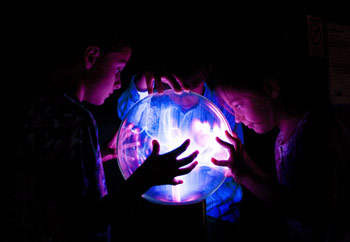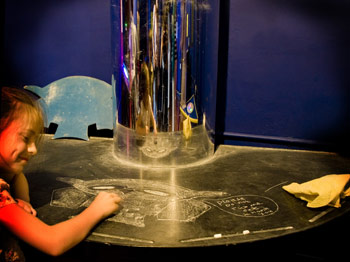Experiment with lenses, lightning and luminosity and many other classic demonstrations on colour and optics. Also investigate how images merge into moving pictures in the zoetrope and praxinoscope, and how much your brain influences what you see.
• A gallery with about 100 sq metres of open floor space.
• Electrical power – eight plug sockets.
• The exhibition must be supervised at all times when in use, preferably by staff accustomed to working in an interactive environment.
Adding colours – Red, green and blue primary coloured lights can be mixed to form white; or red and green can be mixed to make yellow. The colours give an insight into the way the sensors in the eye operate.
Big lens – The concentric grooves on a large sheet of plastic act as tiny prisms. These work together to form a giant, flat magnifying lens in which visitors can see the magnified images of their friends.
Anamorph – A large cylindrical image distorts pictures drawn on the blackboard in front of it. Ttry drawing shapes that look correct when viewed in the mirror.
Bubble wall – Create a large soap film or bubble wall and watch how the interference colours mingle and change.
Multiple reflections – Your eye always follows you around from the centre of the mirrors from whichever direction you look. You can also arrange coloured sticks in the cube to experiment with multiple reflections.
Glow paper – A sheet of light-responsive paper stores a shadowy image of your hand after a photographic flash.
Ghost – Two visitors sit either side of a half-silvered window. By altering the illumination on their faces their reflections merge to give a composite face.
Illusion discs – Three spinning discs with patterns that fool the brain.
Light house – Place prisms and lenses in parallel beams of white light to explore optics.
Light music – Arrange counters on a disc to create music by interrupting beams of light.
Mirror drawing – Test your ability to be trained by trying to draw while looking in a mirror.
Plasma globe – A high-voltage electrode in the middle of the globe makes the gas glow. Touch the globe to draw a stream of glowing gas towards them.
Praxinoscope – An animation illusion based on a Victorian toy.
Spark disc – Bright blue sparks flicker across the disc when you touch the glass or make a loud sound.
See heat – A heating element in a tank of water produces convection patterns. These are viewed as shadows cast on a screen by a point source of light.
Zoetrope – A moving picture illusion based on a Victorian toy.
Note: Note that some of these experiments work best in a darker area
Contact Us
Address
Exhibitions for Hire
Science Projects Ltd
Unit 1, Warren Farm
Steventon
Basingstoke
RG25 3BL, UK
Tel: 020 8741 2305
Email: info@science-projects.org




